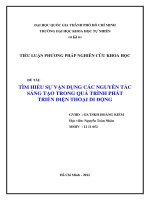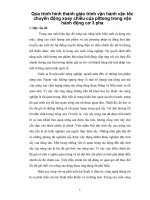Quá trình hình thành giáo trình chuyên ngành điện tử viễn thông - mạng điện thoại tiếng anh chuyên ngành p1 pdf
Bạn đang xem bản rút gọn của tài liệu. Xem và tải ngay bản đầy đủ của tài liệu tại đây (360.68 KB, 4 trang )
Unit 1. The Telephone Network
3
Unit 1. The telephone network
I. GIỚI THIỆU
Bài 1 giới thiệu về các mạng điện thoại, một mạng quốc gia và sự phát triển mở rộng mạng nội
hạt.
1. Mục đích yêu cầu
1. Sau khi nghiên cứu bài 1, sinh viên cần:
2. Phân biệt được các tình huống sử dụng các từ đồng nghĩa.
3. Thành lập hội thoại với các cấu trúc được sử dụng khi không hiểu lời người nói, khi muốn
làm rõ hơn hoặ
c khẳng định người nghe đã hiểu.
4. Nắm được các đặc điểm của một mạng điện thoại quốc gia.
5. Nắm được các cụm từ viết tắt trong kỹ thuật viễn thông.
2. Tóm tắt nội dung
1. be composed of/ consist of/ be made up of/ comprise
be divided/ be broken down/ be separated into
two- both/ two- one- the other/ one- another
2. Interrupting → Asking for clarification
3. Giving clarification → Checking understanding
4. Mạng điện thoại quốc gia gồm mạng nội hạt, m
ạng chuyển tiếp và mạng chính (trung kế)
5. GSC- DSC- MSC- DP- CCP- TSC- PCM- RSS
II. NỘI DUNG
1. READING 1
The UK national network comprises:
a/ The local network
• The lines between the subscriber and the local exchange.
b/ The junction network
• The circuits between a local exchange and another local exchange.
• The circuits between a local exchange and a primary centre, sometimes termed a
tandem exchange.
• The circuits between a local exchange and a secondary centre, sometimes called a
Group Switching Centre (GSC).
c/ The main/ trunk network
• The circuits between GSCs.
Click to buy NOW!
P
D
F
-
X
C
h
a
n
g
e
V
i
e
w
e
r
w
w
w
.
d
o
c
u
-
t
r
a
c
k
.
c
o
m
Click to buy NOW!
P
D
F
-
X
C
h
a
n
g
e
V
i
e
w
e
r
w
w
w
.
d
o
c
u
-
t
r
a
c
k
.
c
o
m
Quá trình hình thành giáo trình chuyên ngành điện
tử viễn thông mạng điện thoại tiếng anh chuyên ngành
Unit 1. The Telephone Network
4
• The circuits between GSCs and tertiary centres, known in the UK as District and
Main Switching Centres (DSCs and MSCs).
Figure 1. The national network
In the local network, each subscriber is connected to a local exchange. To reduce the
number of cables, the local network is usually divided into three parts:
a/ The subscriber circuit: this consists of the telephone set, in the customer’s premises,
and a cable pair, often open-wire line, which is connected to a distribution point (DP).
b/ The secondary circuit: this is made up of a number of pairs (a multi-pair cable)
connected over or underground to a cabinet, sometimes called a cross connection point (CCP).
c/ The primary circuit: this is composed of a number of multi-pair cables ( multi-unit
cable) connected in ducts or in a cable tunnel to the main distribution frame in a local exchange.
Figure 2. The local network
In the trunk network, all non-local calls are set up via a GSC and the main network. In
the UK, 70% of all traffic is routed direct to another GSC, 24% via one other GSC. The traffic
which cannot be handled by these direct routings is carried by a new network, called the Transit
Network. This network, which also carried overseas traffic to the International Gateway
Exchanges, comprises 11 MSCs and 26 DSCs, known collectively as Transit Switching Centres
(TSCs). Transmission on this network can be by coaxial cable or radio link.
Click to buy NOW!
P
D
F
-
X
C
h
a
n
g
e
V
i
e
w
e
r
w
w
w
.
d
o
c
u
-
t
r
a
c
k
.
c
o
m
Click to buy NOW!
P
D
F
-
X
C
h
a
n
g
e
V
i
e
w
e
r
w
w
w
.
d
o
c
u
-
t
r
a
c
k
.
c
o
m
Unit 1. The Telephone Network
5
Figure 3. The analogue trunk network
1.1. Main phrases
- in the customers premises: trong nhà thuê bao
- transmission on the network: truyền dẫn trên mạng
1.2. Complete the labelling of Figures 1, 2 and 3.
Figure 1 : a. ……… network b. …………… network c. ………. network
d. ……………… e. ……………………… f. …………………
Figure 2 : a. ……………… b. ……………………… c. …………………
d. ………………. e. ……………………… f. …………………
g. ………………. h. ……………………… i. …………………
j. ………………. k. ………………………
Figure 3 : a. ………………. b. ……………………… c. …………………
d. ……………… e. ……………………… f. …………………
g. ………………
1.3. Answer the following questions.
1. What do the following abbreviations stand for?
a. GSC … b. DSC … c. MSC …
d. DP … e. CCP… f. TSC …
2. What is another term for?
g. the main network … h. a primary centre …
i. a secondary centre … j. tertiary centre …
k. a cabinet …
3. What other means of transmission are mentioned in the passage
an open wire line l. … m. …
n. … o. … p. …
4. What types of traffic does the transit network carry?
Click to buy NOW!
P
D
F
-
X
C
h
a
n
g
e
V
i
e
w
e
r
w
w
w
.
d
o
c
u
-
t
r
a
c
k
.
c
o
m
Click to buy NOW!
P
D
F
-
X
C
h
a
n
g
e
V
i
e
w
e
r
w
w
w
.
d
o
c
u
-
t
r
a
c
k
.
c
o
m
Unit 1. The Telephone Network
6
q. … r. …
2. LANGUAGE PRACTICE
2.1. Phân loại (Classification)
a. to be composed of
to consist of
to comprise
to be made up of
Những động từ và cụm động từ trên đều có nghĩa “bao gồm”. Trong một bài viết, người ta thường
dùng các từ đồng nghĩa để tránh lặp lại.
Tương tự, ta có các cụm từ khác nhau nhưng đều có nghĩa “được chia thành”.
to be divided into
to be broken down into
to be separated into
Ví dụ: The local network is divided into 3 parts.
The local network is broken down into 3 parts.
The local network is separated into 3 parts.
Động từ “to be” thể hiện sự chắc chắn. Nếu không hoàn toàn chắc chắn, ta dùng một trong những
động từ khiế
m khuyết “can, may, might…”
Ví dụ: The local network can be divided into 3 parts.
The local network can be broken down into 3 parts.
The local network can be separated into 3 parts.
b. two- both/ two- one-the other/ one-another
“ There are two exchanges. Both are traditional electromechanical exchanges.”
“Both” (cả hai) thường được dùng với câu khẳng định để chỉ 2 người, 2 vật, 2 nơi… có cùng một
đặc điểm chung. Tình huống ở đây chỉ 2 tổng đài và cả 2 đều là tổng đài cơ điện cổ truyền.
Khi ta muốn diễn đạt ý phủ định thì thay “both” bằng “neither” và câu đó không cần dùng “not”.
Ví dụ: … Neither are digital.
( Cả 2 đề
u không phải là tổng đài số)
Khi tổng số lượng ta đề cập tới vẫn là 2 nhưng có những đặc điểm khác nhau thì ta dùng “one” và
“the other” để mô tả.
Ví dụ: Two SPC exchanges are installed; one to extend the central area, the other to serve
the new area.
There are two types of cables; one is fibre optic, the other is metallic.
Khi tổng số hơn 2 mà ta chỉ muốn nói tới 1 trong số đó ta dùng “another”.
Ví dụ: 70% traffic is routed direct from one GSC to another GSC.
(70% lưu lượng được truyền thẳng từ 1 GSC tới 1 GSC khác.)
Click to buy NOW!
P
D
F
-
X
C
h
a
n
g
e
V
i
e
w
e
r
w
w
w
.
d
o
c
u
-
t
r
a
c
k
.
c
o
m
Click to buy NOW!
P
D
F
-
X
C
h
a
n
g
e
V
i
e
w
e
r
w
w
w
.
d
o
c
u
-
t
r
a
c
k
.
c
o
m









